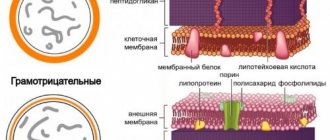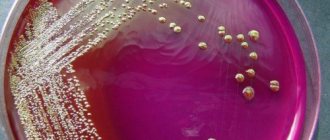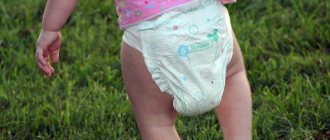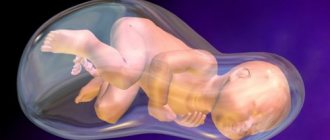The appearance of green stool in a child can cause real panic in parents. However, there is no need to worry: a change in the shade of stool can depend on many factors, most of which are in no way related to pathological processes in the body. For example, in a child under one year of age, green feces are very common, which is associated with the physiological characteristics of the baby’s digestive system.
Reasons for changes in the color of feces
The color of infant bowel movements is influenced by various reasons:
- Type of feeding;
- The diet of the parent (if the baby is breastfed);
- Composition of the mixture;
- Underdevelopment of the gastrointestinal tract of infants.
The body of an infant is not yet fully ready for the digestive process - there are not enough enzymes and beneficial bacteria.
All newborns have a dark green first stool. It is called meconium. This almost black, sticky substance is secreted by the baby the first two to three days after birth. Then the feces become lighter in color. They usually have a light brown, yellowish tint. However, it is also normal for a tiny baby to poop green. Especially if mom’s menu contains a significant amount of cucumbers, parsley, spinach, green pears or apples.
Situations when stool turns light yellow or even white are also dangerous. The table below shows photos of normal feces in a child, as well as feces that signal danger, as in the case of white feces.
The effect of food on baby's stool
The discharge from mother's milk changes color from dark green to golden green. This is a transitional feces, which is formed on the 3-5th day, until milk replaces colostrum. Afterwards, the stool is more uniform, acquires a yellow color, may have whitish lumps, and a faint smell of sour milk. It happens quite often. But we hasten to reassure parents: if the baby is gaining weight, then bowel movements after each feeding should not cause alarm. As the baby grows up, the stool will take shape and become denser and more regular.
Normal stool during breastfeeding:
yellow, slightly greenish color; mushy consistency; sour smell; up to 6-10 bowel movements per day from birth, 1-2 times - closer to a year.
Normal stool color for a baby: shades of yellow, brown, green.
Feces on formula milk are thicker, dark yellow or green in color, and may have a strong odor. The less mixture in supplementary feeding, the yellower the stool. Babies who grow up on formula feeding have fewer bowel movements. And if there is no restless behavior, this indicates a high degree of nutritional absorption. Month after month, a child's stool will become more and more like an adult's stool.
Normal stool with artificial and mixed feeding:
- greenish, yellowish-brownish;
- smear-like consistency;
- more pronounced odor;
- stool once every three days is also normal.
From solid food, the stool changes even more towards the adult, it thickens and turns yellow-brown, but can take on the colors of the food that the child eats while the body adjusts to digesting new foods. Do not be afraid of introducing complementary foods; this is the norm for a cheerful and active baby. But we note the following: accumulations of white lumps of undigested food can “scream” about the introduction of complementary foods in too large volumes, which children’s digestion cannot completely cope with. But foamy, odorous stool with mucus already indicates that complementary feeding is started too early or that these products are not suitable.
How does complementary feeding affect a baby's stool?
- depending on the color of the food, the stool takes on different shades;
- the semi-liquid pulp becomes denser;
- possible increased colic, flatulence;
- vegetables usually cause loose stools, and cereals strengthen them.
An important point is that deviations from the usual frequency and appearance of stool do not always signal illness. And many parents have this experience. However, if changes worsen and new symptoms appear, please consult a doctor.
Colorless, black, blood-streaked stool, a lot of mucus and foam in the baby's stool - it is best to call an ambulance without waiting for a pediatrician's visit.
Reasons for changes in a small child's stool:
- insufficient maturity of the digestive organs, lack of enzymes;
- composition of food for a nursing woman;
- lack of breast milk;
- intolerance to infant formula, complementary foods;
- mother and child taking certain medications;
- physiological jaundice of the newborn;
- imbalance of intestinal microbiota;
- intestinal inflammation;
- viral, bacterial infections;
- food allergy.
Before the age of one year, green and yellow, looser or thicker stools can be either normal or pathological. Frequency and impurities that should not be in the stool of a healthy baby help to distinguish one condition from another.
When to worry and figure out what went wrong:
- white-gray or black stool;
- slurry mixed with mucus and blood;
- green watery stools with foam;
- bowel movements more than 12-15 times a day;
- rare stools: once every 3-5 days or less;
- completely liquid yellow stool with no solid particles;
- gagging in combination with diarrhea, fever;
- the child does not eat well, does not gain or loses weight;
- severe irritation and diaper rash in the diaper area;
- the child is uncommunicative, restless, and whiny.
Causes of green stool in children under 1.5 - 2 years old
Since the gastrointestinal tract is initially immature and does not have enough enzymes to process food, some malfunctions are possible, which will be accompanied by green feces.
The following factors can affect the green coloration of stools:
- changing the diet of a nursing mother (if breastfeeding is natural);
- replacing the mixture with another;
- excess sugar in the mixture;
- excess iron in the mixture;
- indigestion in a baby;
- introducing the first solid food into the baby’s diet;
- teething, when a child pulls various objects into his mouth and thus introduces bacteria into the stomach.
Here you have the opportunity to track the child’s reaction and eliminate some of the reasons yourself, for example, choose a suitable formula, adjust your diet, or postpone the introduction of complementary foods.
If after such changes the stool still remains green, consultation with a specialist is necessary, because perhaps the reason lies deeper.
If a breastfed baby is not properly applied to the breast and sucks out only the liquid front milk, but not the richer rear milk, then his stool may be more liquid and have a green color. Therefore, it is so important that the baby drinks the rear nutritious portion of mother’s milk.
How is it formed and what does it consist of?
From the stomach, food masses enter the duodenum, where they are mixed with bile produced by the liver and digestive enzymes of the pancreas. During the digestion of proteins, fats and carbohydrates, a suspension is formed that moves through the small intestine. The small intestine absorbs nutrients into the blood, and the remaining liquid waste enters the large intestine. In the large intestine, the remaining water is absorbed and feces are formed, which are excreted into the environment through the distal part of the digestive tract - the rectum.
Normal stool consists of water, remains of animal food, undigested plant fibers, bacteria (up to 1/3 of the dry weight of stool), bile, and dead cells of the mucous membrane lining the digestive tract.
Change in stool color in children over 2 years of age
Older children no longer feed on formula or breast milk; their diet contains a lot of foods. Stool may turn green when eating foods such as:
- green vegetables and fruits;
- Red beans;
- sea fish;
- red meat;
- juices, chewing gum and sweets with dyes.
However, foods are not always the source of green stool; the reason may lie:
- helminthic infestation;
- lactase deficiency;
- allergic reaction to certain food groups;
- enterocolitis;
- dysbacteriosis;
- infectious disease;
- taking specific medications and vitamins;
- congenital pathology of the gastrointestinal tract.
If the stool is green, but the child is cheerful, cheerful and there are no additional changes, most likely there is no cause for concern. You should be alert if you experience the following symptoms:
- temperature increase;
- chills, cold sweat;
- nausea, vomiting;
- diarrhea;
- poor appetite;
- child's lethargy and moodiness;
- abdominal pain;
- the presence of impurities of blood, mucus, pus in the stool;
- the appearance of a rash;
- bloating.
Abnormal stool color combined with blood and mucus in it indicates inflammation in the gastrointestinal tract. Fever, vomiting and diarrhea indicate either acute poisoning or an infectious disease.
Therefore, it is necessary to immediately consult a doctor, since the child’s body in this case begins to dehydrate, and the infection and toxins spread further.
Intestinal infections: classification
| Class | Kinds |
| · dysentery; · salmonellosis; · cholera; · typhoid fever; · yersiniosis; · botulism. | |
| · enterovirus; · rotavirus; · adenovirus; · coronavirus. | |
| · giardiasis; · amoebiasis. |
Reason to see a doctor
An increased amount of mucus, green or bloody impurities should alert parents. Against the background of foamy, liquid or foul-smelling stool, their appearance means a state of dysbiosis. As additional signs, the baby may experience frequent colic and skin rashes.
Green stool in a small child sometimes indicates lactase deficiency. Only a doctor who has examined the patient’s tests can confirm the diagnosis.
Thus, before contacting the clinic, parents should carefully analyze the situation. Consider whether the child has taken antibiotics or foods that can change the color of feces. If this is true, the color of bowel movements will stabilize on its own in 2 to 3 days.
When should you see a doctor? A specialist arrives immediately when parents excitedly report the following points by phone:
- vomit;
- diarrhea;
- hyperthermia;
- unbearable colic;
- spasmodic pain in the abdomen;
- greenish feces are excreted for more than 5 days.
What to do if your child's stool is green
As mentioned above, if there are no additional symptoms, you can either take a wait-and-see approach or try to cancel some innovations in the diet. If alarming symptoms are present, you should consult a pediatrician, who, in turn, can refer you to a gastroenterologist, allergist and immunologist.
In order to understand the cause of the child’s condition, it will be necessary to undergo tests:
- blood;
- urine;
- feces;
- anal swab.
In a conversation with doctors, it is necessary to talk in detail about the child’s reactions to food, his diseases (if any), and what new things the baby has tried recently.
In some cases, children undergo an ultrasound of the gastrointestinal tract; they are prohibited from undergoing other procedures such as colonoscopy and endoscopy.
Based on the test results, the doctor makes a diagnosis and prescribes treatment.
Treatment
If the child’s condition worsens, he begins to vomit and have frequent diarrhea, it is necessary to give him special solutions, for example, Regidron, before the ambulance arrives, to normalize the water-salt balance in the body. You can also give any sorbents that are available in your home medicine cabinet, for example, simple activated carbon, Polysorb or Smecta. They will absorb at least some of the toxins from the intestines.
Attention! Giving any additional medications (especially to infants) without the consent of a doctor is dangerous, because the cause of green stool and general malaise is unknown.
Before the doctor arrives, parents are strongly advised not to do the following:
- give an enema to a child;
- give fixing drugs like Loperamide, feces should leave the intestines and not remain in it;
- give painkillers, since the doctor, due to suppressed symptoms, will not be able to understand the exact picture of the disease and begin treatment.
If a child is admitted urgently by ambulance with a diagnosis of green stool and vomiting, he can either be assigned to an infectious diseases department with closed boxes or to an intensive care ward.
Depending on each case, the following procedures can be performed:
- gastric lavage;
- installation of an IV for dehydration.
The doctor may prescribe:
- antibiotics;
- antiviral drugs;
- absorbents;
- enzymatic agents;
- probiotics and prebiotics;
- antifungal agents;
- antibacterial drugs;
- anthelmintic drugs.
After stabilization of the child’s condition, it is necessary to organize the child’s nutrition. Breastfed babies should be put to the breast more often and given boiled water from a bottle to replenish lost fluid. The beneficial substances in mother's milk will help improve the functioning of the gastrointestinal tract.
Formula-fed babies need to choose a suitable lactose-free formula.
Children over the age of one year need to establish a gentle diet, which will include vegetable purees and soups, low-fat fermented milk products, water-based cereals, unsweetened compotes, black tea, and fruit juice.
What to do if you have green stools?
If your stool appears green, the following actions are recommended:
- Ensure that the baby is properly attached to the breast, allow him to get enough and complete breastfeeding on his own.
- Make breastfeeding regular, depending on the body's needs.
- Control your diet during breastfeeding, avoid artificial additives and exotic foods.
- Treat the baby's intestinal dysfunction under the supervision of a doctor.
- Don't worry if your stools turn green after taking Smecta.
- Thoroughly study the composition of artificial complementary foods, ensure optimal selection for the baby’s body (for example, use NAN mixtures).
- Green stools without accompanying warning signs are normal and do not require intervention.
- Use of additional nutrition in due time.
- Dr. Komarovsky can give an online consultation on his website.
- The frequency of green stools in combination with alarming symptoms is a necessity for seeking medical help.
Green stool in a newborn during breastfeeding is not always a deviation. If your child is developing normally, cheerful and active, there is no need to worry once again about why the child has green stool and tirelessly torment the child with visits to the doctor.
Control your diet during breastfeeding, provide your children with proper care, monitor their behavior, and then there will be much less cause for alarm.
Why is diarrhea dangerous?
Diarrhea left without appropriate treatment can lead to serious complications for the body as a whole. The most dangerous of them are the following.
Dehydration
. With diarrhea, the mechanism of water absorption by the intestinal walls is disrupted. Liquid is removed from the body without having time to take part in metabolism. In addition, water is released into the intestinal lumen, which increases fluid loss. It is especially dangerous if a child in the first 2–3 years of life or an adult recovering from a serious illness develops dehydration. It can be dangerous not only to health, but also to life.
Imbalance of electrolytes in the body
. Together with water, the body loses salts, without which the proper functioning of cells, the penetration of necessary substances through their membranes and the removal of products of cellular metabolism are impossible. As a result, this can lead to disruption of vital organs.
Exhaustion
. With diarrhea, especially if it continues for a long time, a deficiency of nutrients, vitamins, minerals and other biologically significant elements often develops. This leads to chronic loss of strength, loss of body weight, and internal organs suffer due to a lack of the substances they need, which affects their functions.
The occurrence of anal fissures
. Constant irritation of the anal area during diarrhea leads to irritation of the rectal mucosa and the skin around the anus. Long-term diarrhea often causes the formation of anal fissures and accompanying symptoms: acute pain and bleeding.
Prevention measures
The introduction of complementary foods must be correct and timely
- A nursing mother must follow a diet.
- It is important to regularly see a pediatrician; if any alarming signs occur, immediately report it to the doctor.
- Artificial formulas should be carefully selected taking into account the individual characteristics of the child.
- Timely and correct introduction of complementary foods.
- Correct diet for toddlers, no overeating.
- Gradual introduction of foods that may cause allergic reactions.
As you can see, there are many reasons why a baby’s stool may change color to green. It's better to play it safe and consult a pediatrician. Do not forget that some factors influencing changes in stool may be dangerous for the child’s body and require early diagnosis.
Causes of constipation in a newborn
Constipation in a newborn is often physiological; it occurs due to the immaturity of the digestive system and unformed reflex bowel movements. And it doesn't need to be treated. But if independent stool is absent for three days or more, the tummy is tense, the child pushes hard and cries, and has lost his appetite, then this is constipation, which is no longer the norm.
According to doctors, constipation from breast milk is rare, for example, when the baby is malnourished. This is also a typical condition on artificial nutrition, especially in the first ten days of introducing the formula, while the body adapts to foreign milk protein. However, thanks to the improvement of production technologies and the approximation of the contents of infant formula to the composition of breast milk, the stool of children on IV may be the same as that of breastfed children.
What should you be wary of?
Stool color isn't the only warning sign
Changes in stool may not always be caused by errors in diet: often green stool is a sign of illness. For children under one year old, dysbacteriosis becomes a common occurrence. This condition is caused by an imbalance of good and bad bacteria. What factors provoke the development of dysbiosis?
Often this condition is a consequence of early complementary feeding and the presence of juices in the baby’s diet. The second reason is previous infection. Everyone knows that taking antibiotics is a provoking factor responsible for the development of dysbiosis (it is not uncommon for dysbiosis to be diagnosed in the children of mothers who took antibiotics and were breastfeeding).
Often, when the first teeth appear, babies become capricious and try in every possible way to alleviate the discomfort that occurs in the oral cavity. Toys and hands carry bacteria into your mouth, causing green poop.
With dysbacteriosis, the child experiences constipation, but more often foamy stools with an unpleasant odor are detected. The child suffers from colic. Mothers notice frequent regurgitation. An appropriate diagnosis is made using stool analysis.
Another option is the appearance of green stool caused by intestinal inflammation and the activity of intestinal bacteria. To prevent this process, you can advise mothers and relatives to stop licking the pacifier. Aggressive adult microbes can cause unpleasant conditions in the children's gastrointestinal tract.
Most infections are the result of the activity of pathogenic flora brought into the mouth with dirty objects. If your immune system is weakened, your own flora can also cause these problems. Microbes that were not previously thought to be dangerous can cause disturbances in the gastrointestinal tract.
Rarely are cases diagnosed when intestinal problems in children are provoked by pathogenic pathogens. Salmonella and E. coli can enter the baby’s body if adults ignore hygiene rules. Dysentery can be suspected when diarrhea and bloody stools appear. The thermometer records a high temperature, and the child suffers from abdominal pain.
You can get salmonellosis by eating raw or undercooked eggs. Domestic chickens also pose a danger, so egg dishes must be cooked.











